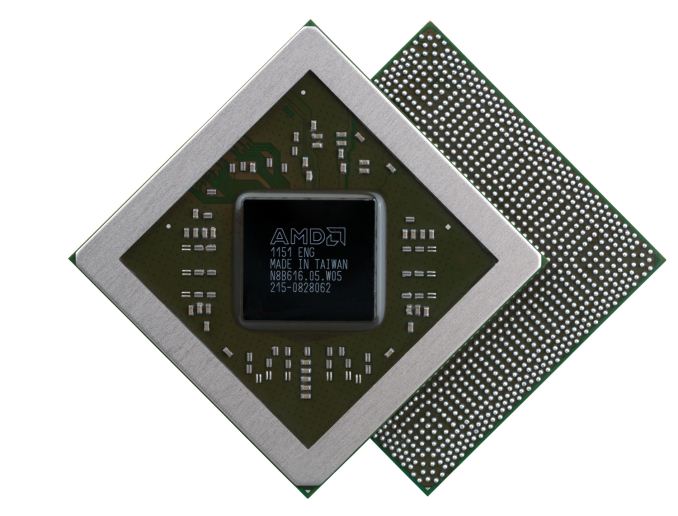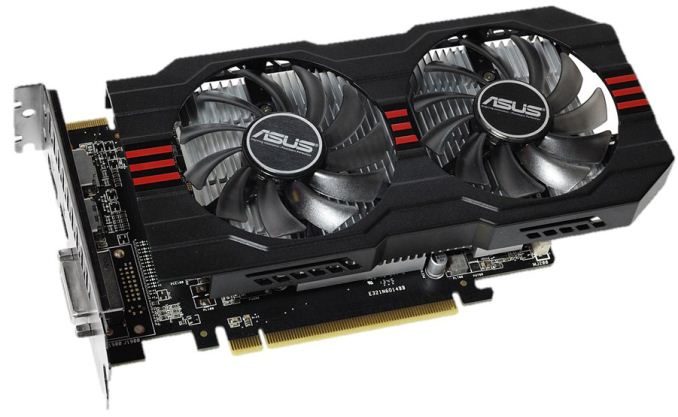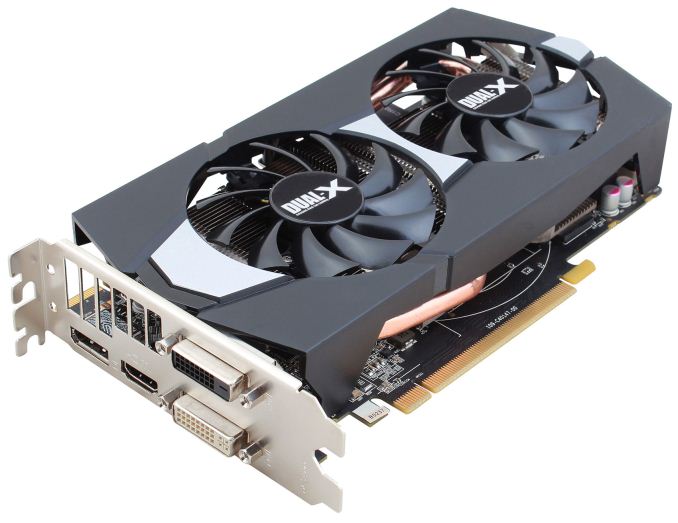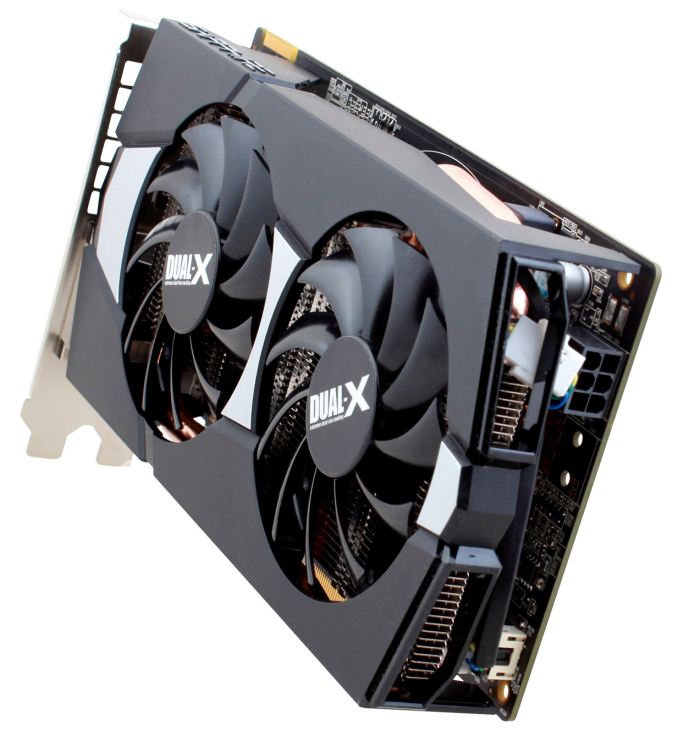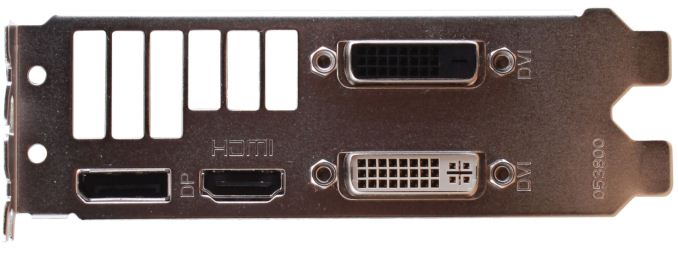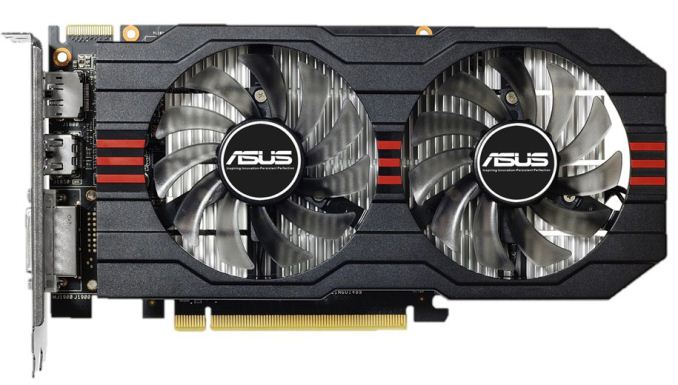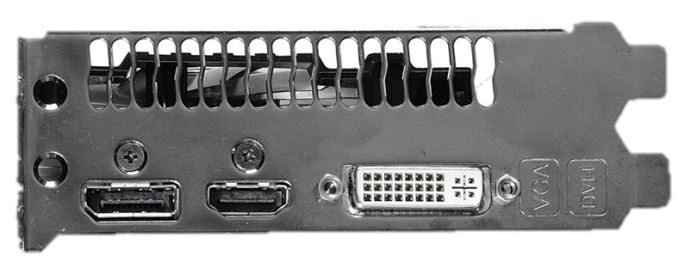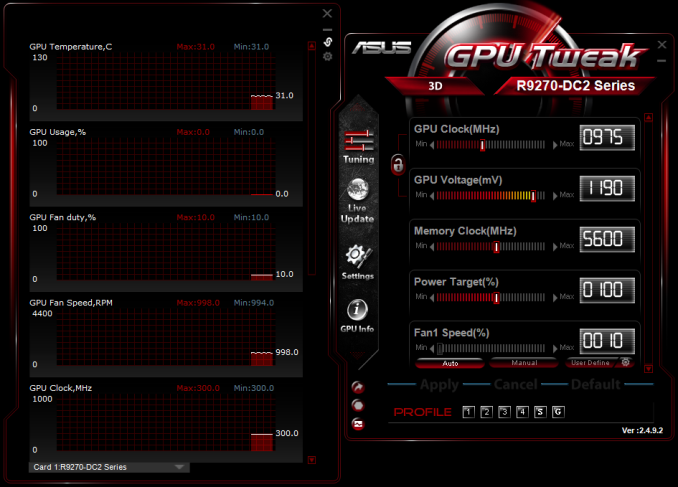
Original Link: https://www.anandtech.com/show/7754/the-amd-radeon-r7-265-r7-260-review-feat-sapphire-asus
The AMD Radeon R7 265 & R7 260 Review: Feat Sapphire & Asus
by Ryan Smith on February 13, 2014 8:00 AM EST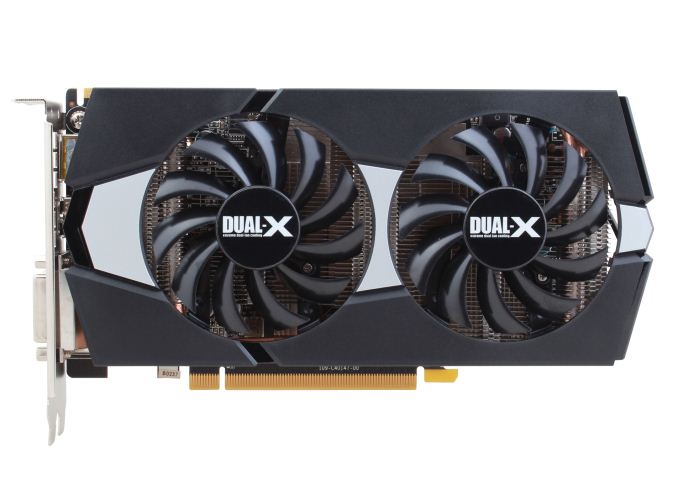
Things are quickly heating up for what should prove to be an interesting February in the desktop video card market. AMD has already been up to bat once this week with the launch of the Radeon R7 250X, pushing AMD’s Cape Verde GPU back into the picture as the new anchor of their $99 price point. Now just 3 days later AMD is coming up to bat again, this time with the Radeon R7 265.
The launch of the 250X earlier this week and now the 265 are part of a larger refactoring of AMD’s mainstream desktop product family. AMD is cutting prices and launching new products both to maintain and enhance their competitive position, and to fill holes in their lineup – however small – to cover as many price points as possible. The end result is that along with a price cut for the existing R7 260X, which will see AMD’s flagship Bonaire part drop to $119, AMD is also using this time to launch parts above it and below it in order to fill the holes this refactoring is creating.
A key part of that refactoring strategy will be today’s launch of the Radeon R7 265. With R7 260X dropping to $119 and R9 270 holding at $179 (MSRP), AMD has a $60 gap that needs to be filled with a new product, and R7 265 is that product. Based on AMD’s venerable Pitcairn GPU, R7 265 will be filling this gap by bringing a variant of the Radeon HD 7850 back to the market, creating a 3rd tier Pitcairn product for the 200 series. Compared to the 7850 that it’s based on, R7 265 is receiving the same GPU clockspeed and memory clockspeed bump that the 7870-derrived R9 270 series saw last year that will make the R7 265 a bit faster than the 7850 it functionally replaces and making it better suited to fill the gap between the R9 270 and R7 260X.
Meanwhile we also have on hand AMD’s Radeon R7 260 (vanilla). First announced back in mid-December and finally reaching shelves towards late January, R7 260 is AMD’s 2nd tier Bonaire part, creating a lower cost, lower performance variant of the R7 260X. Given the close timing of these launches, and since we’re already looking at one 260 series part today in the 265, we’ll also be taking a look at the 260 so that we can take a complete inventory of AMD’s $100-$150 lineup.
| AMD GPU Specification Comparison | ||||||
| AMD Radeon R9 270 | AMD Radeon R7 265 | AMD Radeon R7 260X | AMD Radeon R7 260 | |||
| Stream Processors | 1280 | 1024 | 896 | 768 | ||
| Texture Units | 80 | 64 | 56 | 48 | ||
| ROPs | 32 | 32 | 16 | 16 | ||
| Core Clock | 900MHz | 900MHz | ? | ? | ||
| Boost Clock | 925MHz | 925MHz | 1100MHz | 1000MHz | ||
| Memory Clock | 5.6GHz GDDR5 | 5.6GHz GDDR5 | 6.5GHz GDDR5 | 6GHz GDDR5 | ||
| Memory Bus Width | 256-bit | 256-bit | 128-bit | 128-bit | ||
| VRAM | 2GB | 2GB | 2GB | 1GB | ||
| FP64 | 1/16 | 1/16 | 1/16 | 1/16 | ||
| TrueAudio | N | N | Y | Y | ||
| Transistor Count | 2.8B | 2.8B | 2.08B | 2.08B | ||
| Typical Board Power | 150W | 150W | 115W | 95W | ||
| Manufacturing Process | TSMC 28nm | TSMC 28nm | TSMC 28nm | TSMC 28nm | ||
| Architecture | GCN 1.0 | GCN 1.0 | GCN 1.1 | GCN 1.1 | ||
| GPU | Pitcairn | Pitcairn | Bonaire | Bonaire | ||
| Launch Date | 11/13/13 | 02/13/14 | 10/11/13 | 01/14/14 | ||
| Launch Price | $179 | $149 | $139 | $109 | ||
Starting off with the R7 265, from a specification standpoint the 265 is a rather straightforward specification bump of the 7850, or an equally straightforward harvesting of the R9 270 depending on your point of view. Taken from the latter point of view, 265 is nearly identical to 270, dropping 4 CUs and leaving 265 at 16 CUs (1024 SPs) but otherwise leaving it unchanged. This means all 32 ROPs are intact, along with the full 256-bit memory bus.
Clockspeeds on the other hand are identical to the 270. 265 gets the same 900MHz base clock and 925MHz boost clock, and meanwhile the memory clock for the card’s 2GB of GDDR5 stands at 5.6GHz. This means that the entirety of the performance differences between the 265 and 270 will come down to the 4 CU gap between the two cards, giving 265 80% of the theoretical shader/texturing performance of 270, 100% of the ROP throughput, and 100% of the memory bandwidth. As a result the performance difference between the cards will depend on whether any given test is shader/texture bound – which is most games these days – or ROP/memory bound.
Meanwhile 265’s official “typical board power” stands at 150W, the same as the 270. 3rd tier parts rarely see a reduction in power consumption, so this is not unexpected. Though in practice power consumption should be at least marginally lower than 270’s.
Based on specs alone the 265 should be a strong competitor, but the one downside to its introduction will be the disruption of AMD’s 200 series namespace. AMD backed themselves into a corner by starting with 270 (vanilla) for their 270 series products, and as a result they didn’t leave themselves any space to name a lower tier Pitcairn product, short of using even more absurd suffixes (such as the return of LE). As a result AMD has made the next best move by naming it 265, which is clearly below 270, but complicates any discussion about the Radeon R7 260 series as a whole. Due to 265 being Pitcairn based – a GCN 1.0 GPU – this means the 265 lacks functionality such as TrueAudio and XDMA that are found on the Bonaire (GCN 1.1) based R7 260X and R7 260. Consequently it’s no longer safe to say that all 260 series cards support those features; we’ll now have to specifically name Bonaire cards to avoid confusion.
Moving on to our other card for the day, at the other end of the spectrum we have the R7 260. For 260 AMD has cut off 2 CUs, bringing the CU count down to 12 (768 SPs) and the texture unit count down to 48. The ROPs and the memory bus on the other hand remain unchanged at 16 ROPs and a 128-bit memory bus respectively.
Meanwhile clockspeeds have also been reined in slightly versus 260X in order to allow some binning and to create a bit more of a divergence between the 260 and 260X. 260 tops out at 1GHz for the GPU clock and 6GHz for the memory clock, down from 1.1GHz and 6.5GHz respectively for the 260X. Combined with the reduced CU count from earlier, this puts theoretical performance for 260 at around 80% of 260X in shader/texture bound scenarios, and 92% in ROP or memory bound scenarios.
On a side note, unlike all of AMD’s other GCN based products, Bonaire continues to flummox us as far as GPU clockspeeds are concerned. AMD continues to not publish their base GPU clockspeeds, opting only to publish the boost clockspeeds. But unlike Hawaii and other GCN 1.1 based cards, Bonaire based cards have no discernable base clockspeed – we’ve been unable to find a point where these products bottom-out at – so the true base clockspeeds of 260 and 260X are unknown to us. In this case the concept of a base clockspeed and a boost clockspeed are extremely muddled; the 260 either doesn’t drop low enough to hit its base clockspeed, or quite possibly doesn’t have one at all. The end result is that 260 runs as fast as it can under all loads (which is almost always 1GHz) with no minimum guarantee.
In any case, going hand-in-hand with lower performance and lower clockspeeds will be lower power consumption. AMD’s official specifications for typical board power for the 260 is 95W, down from 115W on 260X. This means 260 will still require 1 PCIe power connector – Bonaire’s simply too big for sub-75W operation in a desktop SKU – but it will still be felt in very low power builds where every watt matters.
Moving on to pricing and positioning, as we mentioned before today’s launch of the 265 and the recent launch of the 260 are part of a larger refactoring of AMD’s mainstream product lineup. AMD’s 250 lineup will be concentrated at sub-$100, the 270 lineup at $180+, and the 260 lineup will be at $100-$150. Specifically we’ll be looking at the 265 at $149, the price adjusted 260X at $119, and the 260 at $109, occupying a very narrow gap between the $99 250X and $119 260X. AMD’s only previous cards in this space were last-generation 7770 series cards and the 260X at $139, so this represents a significant increase in the density of AMD’s product stack in this price range.
| AMD Radeon Sub-$150 MSRP Changes | ||||||
| Product | GPU | Old Price | New Price | |||
| Radeon R7 265 | Pitcairn | N/A | $149 | |||
| Radeon R7 260X | Bonaire | $139 | $119 | |||
| Radeon R7 260 | Bonaire | N/A | $109 | |||
| Radeon R7 250X | Cape Verde | N/A | $99 | |||
Unfortunately, both actual pricing and availability are likely to end up being a bit of a mess, and that goes for both products. To our chagrin, 265 is going to be another soft launch; AMD is not expecting cards to hit the shelves until the end of this month, roughly 2 weeks from now. But compounding that is the fact that AMD is already 0-for-1 on launch availability predictions this week, after 250X failed to materialize at retailers as originally projected. AMD tells us that this was due to Chinese New Year, and that with the New Year vacations now at an end, production will pick back up in time for the 265 launch. This is a rational enough explanation, but we’re taking a wait & see approach all the same.
But perhaps the biggest concern is whether retail pricing will actually match AMD’s MSRPs. In the last couple of weeks pricing and availability for 270 series cards has (in a word) taken a turn for the absurd, with supplies dropping and prices increasing. When Newegg has (as of this writing) 1 270 in stock for $250, and 270Xs starting at $280, it’s hard to imagine another Pitcairn card like 265 is going to be left unaffected at $149. Admittedly it’s not clear at this time why 270 series pricing is so outrageous – Cryptocoin Mania hasn’t previously influenced Pitcairn cards – but unless something changes to bring the other Pitcairn cards back down to their MSRPs, then $149 for 265 may be an unreasonable expectation.
As for the 260, even though it already launched last month, availability and pricing are already sketchy. AMD’s board partners have been slow to take up the 260, and as a result the number of models on the market is very limited, amounting to just a handful in North America. The lack of selection has done no favors for the pricing, leading to 260 prices starting at $125. This is $15 above MSRP – a significant difference for this segment of the market – and just a stone’s throw away from the 260X at current prices. If the 260X price adjustment goes through as planned, then 260 needs to come down to its proper MSRP to have a place in the market.
Finally, for the time being NVIDIA’s competition is going to be spread out, leaving a lack of direct competition for AMD’s latest arrivals. With the retirement of GTX 650 Ti Boost, NVIDIA doesn’t currently have a product directly opposite 265 at $149, with GTX 660 well above it and GTX 650 Ti well below it. On the other hand, NVIDIA’s closest competition for 260 as it stands is GTX 650 Ti, though this would shift if 260X cards quickly hit their new $119 MSRP.
| Winter 2014 GPU Pricing Comparison | |||||
| AMD | Price | NVIDIA | |||
| Radeon R9 270 | $250 | GeForce GTX 760 | |||
| $190 | GeForce GTX 660 | ||||
| Radeon R7 265 | $150 | ||||
| Radeon R7 260 | $125 | ||||
| Radeon R7 260X (New MSRP) | $120 | GeForce GTX 650 Ti | |||
| Radeon R7 250X | $100 | GeForce GTX 650 | |||
| Radeon R7 250 | $90 | GeForce GT 640 | |||
Meet The Sapphire Radeon R7 265
Since the R7 265 is a variant of the existing R7 270 series, AMD isn’t creating a reference card this time around. In lieu of that they have been sending the press Pitcairn cards reprogrammed to the 265 specification, which gives us something suitable to test but doesn’t necessarily represent what the final retail products will look like. For our sample we received a board based on Sapphire’s Radeon R9 270 Dual-X design.
Because we don’t know at this time whether this specific card will be a retail product or not, we’re not in a position to talk about it in depth. But we did want to discuss it briefly, as we expect most (if not all) retail R7 265 cards to be built in a similar manner, especially for the board partners reusing their existing R9 270 designs as was the case here.
Sapphire’s design is fairly typical for a 150W AMD card. Here Sapphire utilizes a compact form of their Dual-X cooler, relying on a pair of 75mm fans mounted over an aluminum heatsink, with a pair of copper heatpipes providing a connection between the heatsink and the Pitcairn GPU underneath. A baseplate brings the package together, providing cooling for the RAM and VRMs, relying on small grooves at various areas to function as a quasi-heatsink and improve convection. This means that it is of course an open air design, and while 150W is not trouble for most cases these days it does bear mentioning.
Sapphire’s Dual-X cooler runs 8.5” long, causing it to slightly overhang the 7.9” PCB. The card doesn’t feature a dedicated stiffening mechanism of any kind, but the baseplate is just large enough to provide the necessary rigidity on its own. Elsewhere the required 6pin PCIe power socket is located at far end of the PCB, orientated parallel to the PCB itself and slightly obscured by the card’s shroud; so you’ll need a bit more room behind the card to work in the necessary power cabling.
Finally, at the front end of the card we find half slot vent, coupled with AMD’s current generation I/O layout of 1x DisplayPort, 1x HDMI, and 2x DL-DVI. Notably, Sapphire has also added themselves to the pool of board partners with this design by using a wider grating spacing in an attempt to improve airflow, subdividing their vent into just 6 relatively large segments.
Meet The Asus Radeon R7 260
Our other card of the day is our R7 260 sample from AMD, which comes in the form of a complete retail card: Asus’s Radeon R7 260. This is a standard retail card, featuring a solid design but no factory overclock or other frills.
Surprisingly for a 95W card, Asus’s card is a dual fan open air design. Based on a variation of their dual fan coolers, Asus utilizes a relatively simple aluminum heatsink directly mounted to the Bonaire GPU beneath. This heatsink has a large base that serves to cover the RAM, but not the VRMs towards the front of the card, and mushrooms out at the top to form a larger surface for the dual fans to cool. Truth be told we were pleasantly surprised by this design; these larger dual fan designs are uncommon for sub-100W cards, and even with the relatively simple heatsink it’s essentially oversized for the GPU in question, though as we’ll see in our noise results this is clearly to the benefit of the user.
As a result of using such a large cooler on such a small board, the Asus R7 260’s cooler significantly overhangs the PCB. The PCB itself is just 6.8” long, while the cooler extends a further 1.9” to give the card a total length of 8.7”. As is usual for Asus, the card feature’s Asus’s Super Alloy Power discrete electrical components for enhanced durability. Meanwhile the fact that this is closer to a card strapped to a cooler than a cooler strapped to a card doesn’t do Asus any favors, especially since the GPU is towards the rear of the card. The short length of the card ensures it’s rigid enough, but there’s some opportunity for flexing towards the front of the card.
For Asus’s power connectivity, the single 6-pin PCIe power socket is found at the end of the card, orientated parallel to the PCB despite the significant overhang of the cooler. To make up for this, Asus has once again reversed the PCIe power socket so that the tab on the plug faces inwards instead of outwards, which makes this design practical as the cooler no longer blocks the tab.
As for Asus’s display I/O, Asus is using a simpler port layout that occupies just a single slot, presumably so that this PCB is capable of being used on single-slot designs if necessary. This results in the card having 1x DL-DVI, 1x HDMI, and happily enough for such a low-end card, 1x DisplayPort, as opposed to a VGA port. This gives the Asus card the ability to drive three digital displays at once for Eyefinity, or even a single 4K display if we’re talking about simple desktop work.
Meanwhile on the software side of things the R7 260 comes with Asus’s standard GPUTweak software utility. GPUTweak is a very competent overclocking suite that offers all of the overclocking and monitoring functionality we’ve come to expect from a good overclocking utility, including a wide array of monitoring options and support for GPU voltage control. Asus’s taste in skins is unfortunate – a low contrast red on black – but otherwise the UI itself is similarly solid. To that end GPU Tweak won’t match Afterburner on some of its more fringe features such as recording and overlays, but as a pure overclocking utility it stands up rather nicely.
Wrapping things up, as one of the only two R7 260 graphics cards currently Asus is both enjoying and being disrupted by the lack of sensible pricing among R7 260 cards. At a current retail price of $139 the Asus R7 260 is a full $30 (28%) over what should be a $109 MSRP for an R7 260 card, and $15 more expensive than the alternative MSI card. More importantly, it’s currently just as expensive as the more powerful R7 260X, which puts this card in an unfortunate spot since you can easily buy a more powerful card for less. Asus can enjoy a small premium from a good design and their 3 year warranty, but this is an especially treacherous position if R7 260X prices quickly come down to $119.
Finally, on a quick technical note we do want to point out that we have encountered one minor oddity with the Asus R7 260 that as of this writing is still being looked into by AMD. The card we received has its GPU idle clockspeed at 550MHz, instead of the 300MHz clockspeed that is common for all other AMD GCN cards, including their other Bonaire cards. The ramifications of this are minimal as it doesn’t affect the load performance of the card in any way, but it does mean the card is technically running at a higher clockspeed than it should at idle, which can affect idle power consumption. We’re seeing 74W at the wall, the same as our reference R7 260X, but our GPU testbed is admittedly not well suited to picking up small fluctuations in idle power consumption like this on such a low powered card. In any case we don’t believe it to be a dealbreaker, but AMD is currently looking into it to try to determine what’s going on.
The Test
Starting with this review we are moving to the latest iteration of our GPU benchmark suite, which drops Battlefield 3 for a now far more stable Battlefield 4. We had been hoping to further augment the list to bring it to 10 games, but our other candidates from the late-fall/winter releases have proven unsuitable for benchmarking (e.g. Assassin’s Creed IV framerate cap), so we’re staying with 9 games for the time being.
For this review we’ve also updated all of our included AMD cards to account for AMD’s recently released Catalyst 14.1 beta driver, although the performance impact from it on our current test suite is minimal. We would note that we have encountered random stability issues with this driver that were not present on 13.12, resulting in a driver crash and a system hard-lock at various times.
| CPU: | Intel Core i7-4960X @ 4.2GHz |
| Motherboard: | ASRock Fatal1ty X79 Professional |
| Power Supply: | Corsair AX1200i |
| Hard Disk: | Samsung SSD 840 EVO (750GB) |
| Memory: | G.Skill RipjawZ DDR3-1866 4 x 8GB (9-10-9-26) |
| Case: | NZXT Phantom 630 Windowed Edition |
| Monitor: | Asus PQ321 |
| Video Cards: |
XFX Radeon R9 280X Double Dissipation AMD Radeon HD 7950 Boost AMD Radeon HD 7870 AMD Radeon HD 7850 AMD Radeon HD 7770 AMD Radeon R9 270X HIS Radeon R9 270 IceQ X2 Asus Radeon R9 270 DirectCU II OC NVIDIA GeForce GTX 760 NVIDIA GeForce GTX 660 NVIDIA GeForce GTX 650 Ti Boost |
| Video Drivers: |
NVIDIA Release 334.67 Beta AMD Catalyst 14.1 Beta v1.6 |
| OS: | Windows 8.1 Pro |
Metro: Last Light
As always, kicking off our look at performance is 4A Games’ latest entry in their Metro series of subterranean shooters, Metro: Last Light. The original Metro: 2033 was a graphically punishing game for its time and Metro: Last Light is in its own right too. On the other hand it scales well with resolution and quality settings, so it’s still playable on lower end hardware.
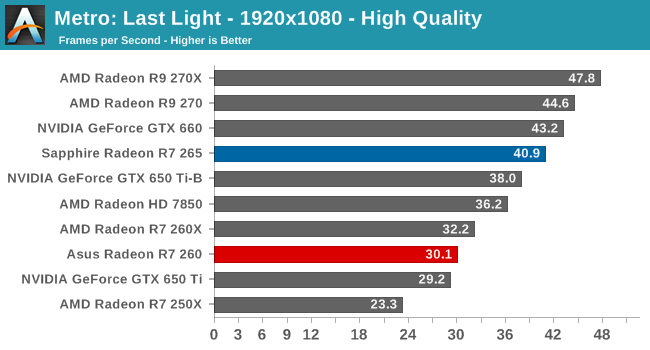
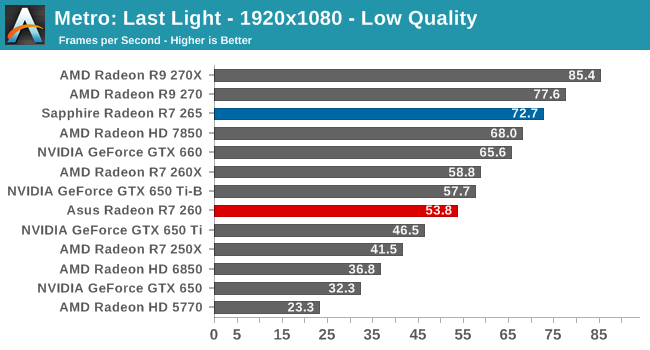
With AMD’s R7 260 series restructuring, NVIDIA’s closest competitor to the R7 265 and R7 260 for the moment is the GTX 650 Ti, with the GTX 660 also partially competing with the R7 265 from above. A win for AMD in this case is for the R7 260 to beat the GTX 650 Ti, and for the R7 265 to come within striking distance of the GTX 660.
To that end, both of AMD’s new cards have little trouble hitting their goals under Metro. At high quality settings the R7 265 is within 6% of the GTX 660 while the R7 260 edges out the GTX 650 Ti. Meanwhile at lower quality settings, where both cards should be far more playable than the 30-40fps rates we saw at high quality, both cards easily surpass NVIDIA’s closest competitors.
Company of Heroes 2
Our second benchmark in our benchmark suite is Relic Games’ Company of Heroes 2, the developer’s World War II Eastern Front themed RTS. For Company of Heroes 2 Relic was kind enough to put together a very strenuous built-in benchmark that was captured from one of the most demanding, snow-bound maps in the game, giving us a great look at CoH2’s performance at its worst. Consequently if a card can do well here then it should have no trouble throughout the rest of the game.
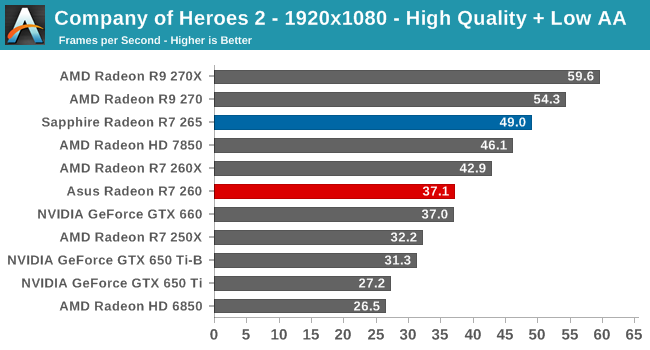
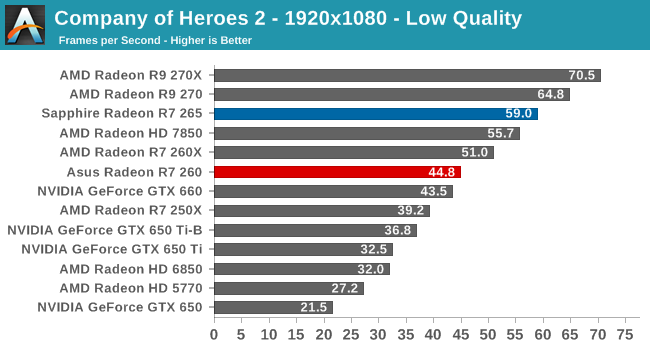
Company of Heroes 2 is a game that has consistently favored AMD’s GPUs, so the outcome here is no surprise. The R7 260 is performance competitive with the otherwise much more expensive GTX 660, leaving the R7 265 to happy stomp all over every NVIDIA card on this chart.
On a side note, for Radeon 5700 series owners looking for an AMD card that can double their performance for under $150, it looks like AMD has finally delivered, as evidenced by the performance of the R7 265 in this and other games. We’re looking at a fairly consistent 100% increase in performance here, which this coming some 4 years after the 5770 launched at $159 is clearly a long wait, but it does happen to coincide nicely with the 4 year upgrade cycle that many video card buyers are on these days.
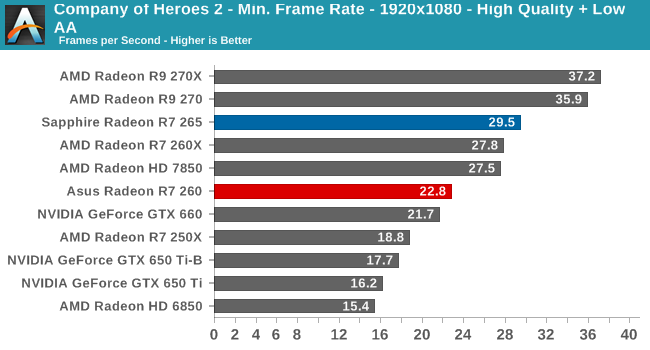
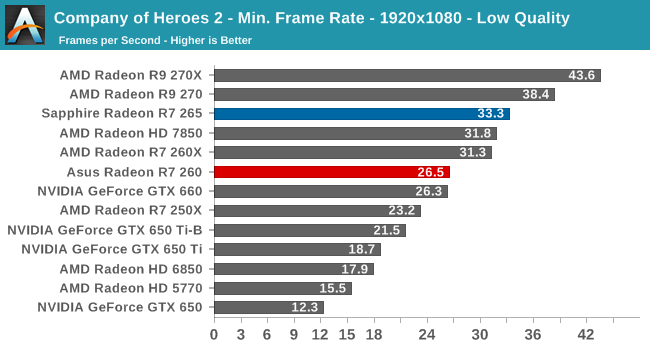
Bioshock Infinite
Bioshock Infinite is Irrational Games’ latest entry in the Bioshock franchise. Though it’s based on Unreal Engine 3 – making it our obligatory UE3 game – Irrational had added a number of effects that make the game rather GPU-intensive on its highest settings. As an added bonus it includes a built-in benchmark composed of several scenes, a rarity for UE3 engine games, so we can easily get a good representation of what Bioshock’s performance is like.
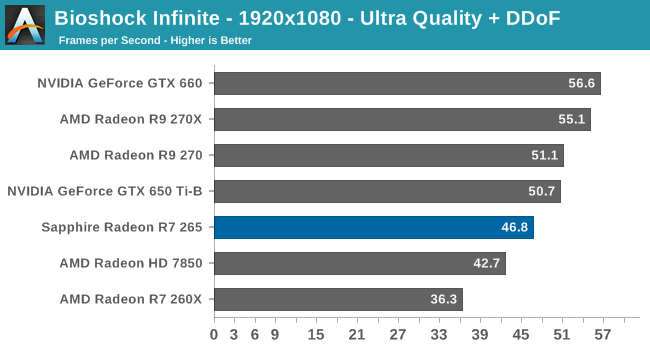
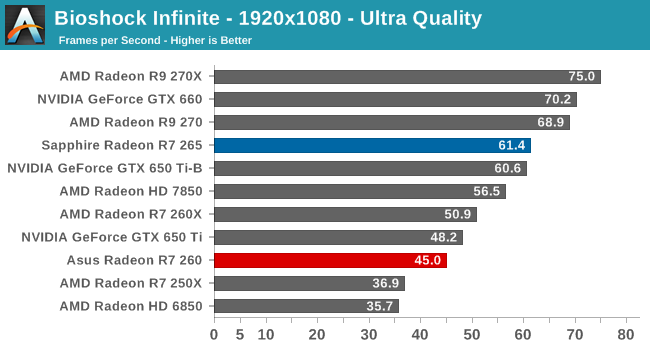

Bioshock is one of a handful of times where we’ll see the new R7 260 series cards struggle against their GeForce competition. At ultra quality, a very playable framerate for both cards, the R7 265 falls behind the GTX 660 but still does reasonably well for the price, but the R7 260 is unable to keep up with the GTX 650 Ti.
Battlefield 4
Our latest addition to our benchmark suite and our current major multiplayer action game of our benchmark suite is Battlefield 4, DICE’s 2013 multiplayer military shooter. After a rocky start, Battlefield 4 has finally reached a point where it’s stable enough for benchmark use, giving us the ability to profile one of the most popular and strenuous shooters out there. As these benchmarks are from single player mode, based on our experiences our rule of thumb here is that multiplayer framerates will dip to half our single player framerates, which means a card needs to be able to average at least 60fps if it’s to be able to hold up in multiplayer.
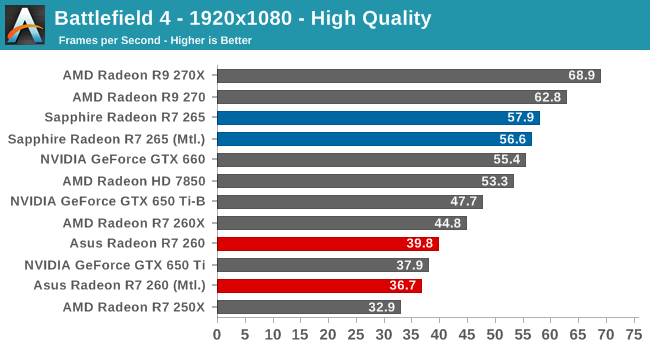
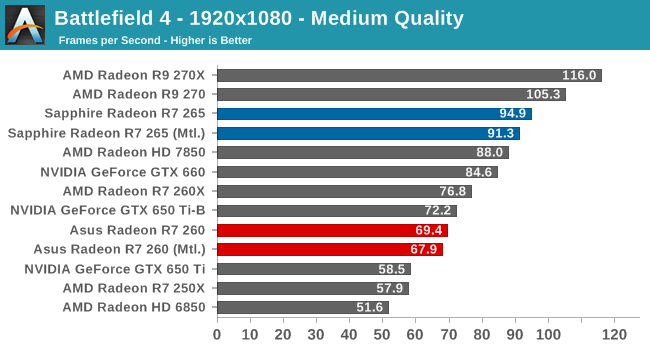

Our first review with Battlefield 4 finds AMD firmly in the driver’s seat, easily surpassing NVIDIA’s closest competitors while often putting more expensive NVIDIA cards in a bind. To this end we see that both the R7 265 and R7 260 are best suited for 1080p at medium quality, as the R7 265’s additional performance comes up a bit short of making high quality playable.
Ultimately we have the R7 260 beating the GTX 650 Ti by 19% and the R7 265 even beating the GTX 660, in the latter case by 12%. Unfortunately for AMD, Mantle is a bust here. In this GPU bound test Mantle is just as likely to cause a minor performance regression as it is to cause a minor performance improvement. Mantle’s strength is in CPU bound scenarios so this isn’t a big surprise, but it does reiterate the fact that Direct3D isn’t dead on AMD cards when you have the CPU power to keep it happy.
Crysis 3
Still one of our most punishing benchmarks, Crysis 3 needs no introduction. With Crysis 3, Crytek has gone back to trying to kill computers and still holds “most punishing shooter” title in our benchmark suite. Only in a handful of setups can we even run Crysis 3 at its highest (Very High) settings, and that’s still without AA. Crysis 1 was an excellent template for the kind of performance required to drive games for the next few years, and Crysis 3 looks to be much the same for 2014.
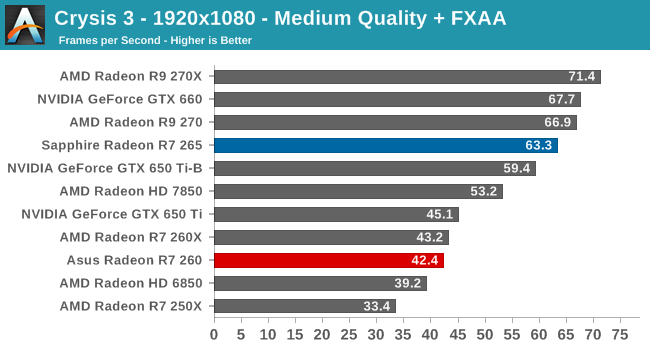
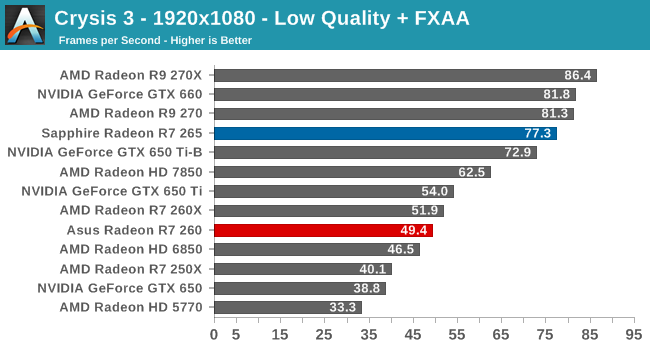
Crysis 3 ends up being the other game that AMD’s latest cards have some trouble with. The R7 260 simply doesn’t have what it takes to catch the GTX 650 Ti, seeming due to a memory bandwidth bottleneck. Meanwhile the R7 265 isn’t going to catch up to the GTX 660, but with that full 256-bit memory bus and the higher memory clockspeeds Pitcairn parts enjoy on the 200 series versus the 7800 series, it has enough memory bandwidth to hold close to the GTX 660.
Which on that note, this is by far the biggest lead the R7 265 has over the 7850. Between the higher clockspeed and the even greater memory bandwidth increase, it pulls well ahead of its most direct predecessor, giving it enough performance to average better than 60fps even on Medium settings, which is quite the accomplishment for a sub-$150 card on Crysis 3.
Crysis: Warhead
Up next is our legacy title for 2013/2014, Crysis: Warhead. The stand-alone expansion to 2007’s Crysis, at over 5 years old Crysis: Warhead can still beat most systems down. Crysis was intended to be future-looking as far as performance and visual quality goes, and it has clearly achieved that. We’ve only finally reached the point where single-GPU cards have come out that can hit 60fps at 1920 with 4xAA, never mind 2560 and beyond.
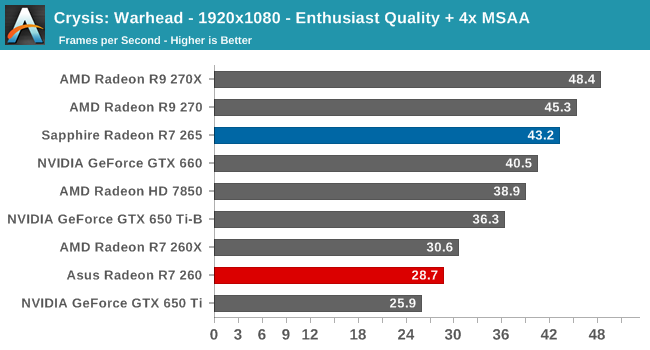
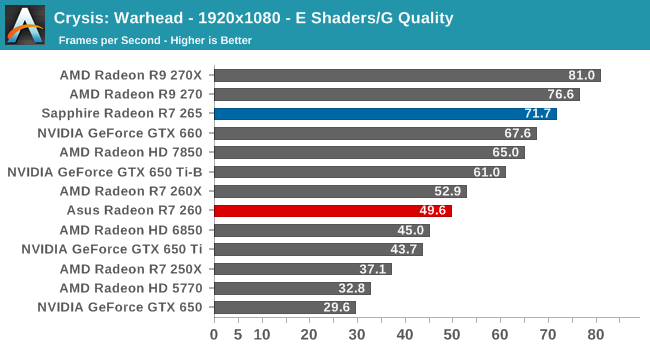
For Crysis: Warhead, AMD is once again in control. The R7 265 trails only the other 200 series Pitcairn cards, passing the GTX 660 by 6%. Meanwhile the R7 260 holds an even greater 14% advantage over the GTX 650 Ti.
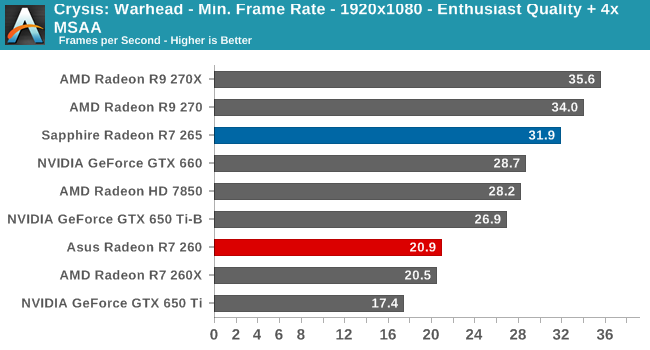
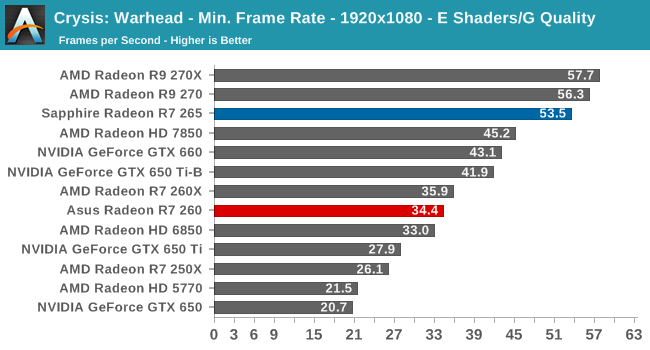
Total War: Rome 2
The second strategy game in our benchmark suite, Total War: Rome 2 is the latest game in the Total War franchise. Total War games have traditionally been a mix of CPU and GPU bottlenecks, so it takes a good system on both ends of the equation to do well here. In this case the game comes with a built-in benchmark that plays out over a forested area with a large number of units, definitely stressing the GPU in particular.
For this game in particular we’ve also gone and turned down the shadows to medium. Rome’s shadows are extremely CPU intensive (as opposed to GPU intensive), so this keeps us from CPU bottlenecking nearly as easily.
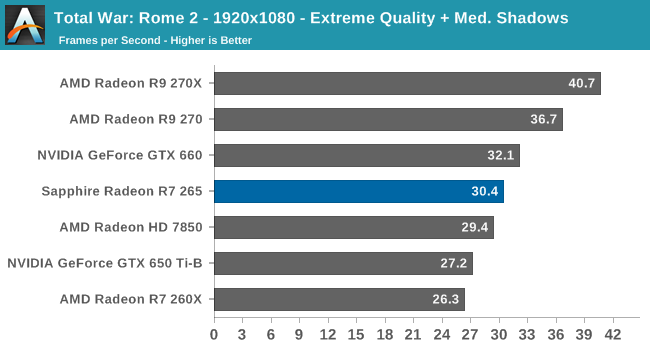

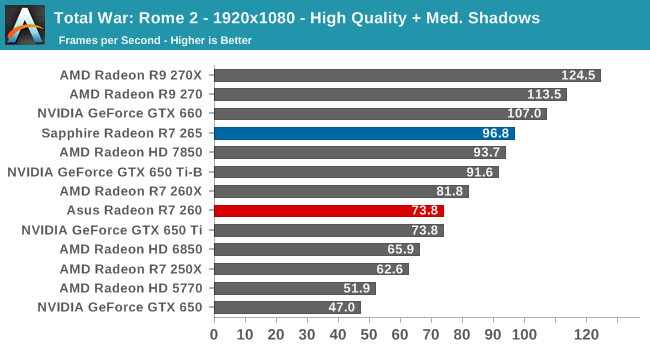
Total War: Rome 2 is a solid showing for AMD’s new cards, but it’s not a blow-out in either direction. Here we find the R7 260 generally tied with the GTX 650 Ti, while the R7 265 trails the GTX 660 by around 5% at Very High quality settings. Meanwhile the R7 265 also just cracks 30fps at Extreme quality settings, though it’s close enough that I suspect most players will want to err on the side of caution and turn down the quality settings for a framerate that will have a much easier time staying above 30fps.
Hitman: Absolution
The second-to-last game in our lineup is Hitman: Absolution. The latest game in Square Enix’s stealth-action series, Hitman: Absolution is a DirectX 11 based title that though a bit heavy on the CPU, can give most GPUs a run for their money. Furthermore it has a built-in benchmark, which gives it a level of standardization that fewer and fewer benchmarks possess.
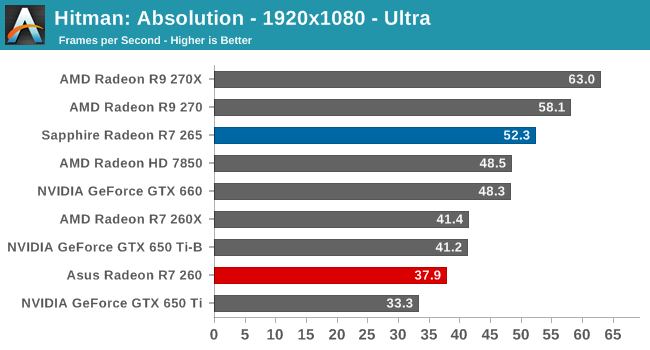

With Hitman: Absolution we’re once again back to a benchmark that AMD’s latest R7 260 series cards have little trouble taking the lead on. In this case the R7 265 surpasses the GTX 660 by 8% at both Ultra and Medium settings, while the R7 260 beats the GTX 650 Ti by 14% or more.
Stopping for a moment to take a look at some of our slower AMD cards, we can also see just how much things have improved over both the R7 250X and cards like the 5770. In the case of the R7 250X, the R7 260, a card with an MSRP all of $10 higher, is 24% faster, demonstrating just how much of a better value the R7 260 is in this AMD product stack, at least if it were priced where it should be. Meanwhile the R7 265 more than doubles the 5770 here, improving on the 5770’s performance by 2.2x.

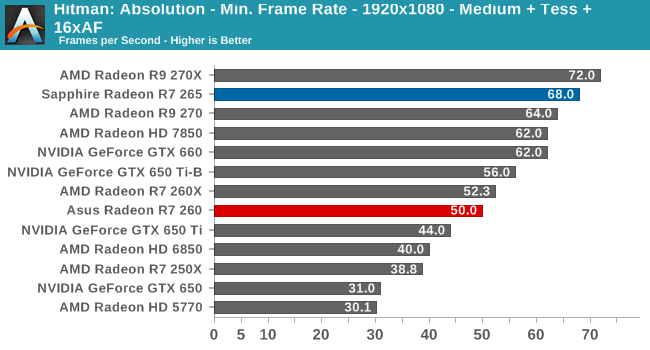
GRID 2
The final game in our benchmark suite is also our racing entry, Codemasters’ GRID 2. Codemasters continues to set the bar for graphical fidelity in racing games, and with GRID 2 they’ve gone back to racing on the pavement, bringing to life cities and highways alike. Based on their in-house EGO engine, GRID 2 includes a DirectCompute based advanced lighting system in its highest quality settings, which incurs a significant performance penalty but does a good job of emulating more realistic lighting within the game world.

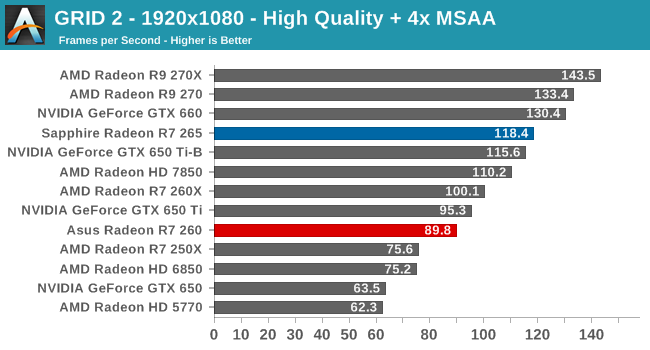
The heavy shader workload presented by GRID 2’s lighting system is enough to significantly shake up our results compared to what we’ve seen with most other games. The performance gap between the R7 265 and R9 270 is very significant here, as the 20% gap in theoretical shader performance translates into an almost perfect 15% gap in performance. On the other hand the R7 260 once again easily flies by the R7 250X, taking an 18% lead.
On the other hand, compared to NVIDIA’s cards, the R7 265 does relatively well here. It won’t surpass the GTX 660 at either resolution, but it’s enough to hold close to its more expensive competitor. But the R7 260 will fall behind the GTX 650 Ti when using high quality settings, which is going to be necessary to hit the high framerates that racing games play best with.
Synthetics
As always we’ll also take a quick look at synthetic performance. Since the R7 265 and R7 260 are based on the same venerable AMD GCN GPUs we've come to know over the last 1-2 years, there shouldn’t be any surprises here other than slight performance differences..
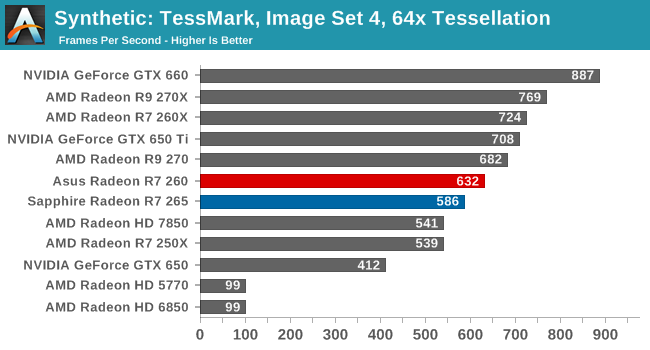
Right off the bat, TessMark highlights an interesting outcome of AMD’s clockspeed choices when paired with their geometry frontend design. Since both Pitcairn (R7 265) and Bonaire (R7 260) have the same 2 triangle/clock geometry rate, the higher clocked R7 260 actually offers better tessellation performance than the lower clocked R7 265. In gaming workloads of course there’s more than just geometry throughput to be concerned about, but this does bring to light one of those amusing edge cases where cards on either side of a GPU upgrade aren’t always faster than they first appear.
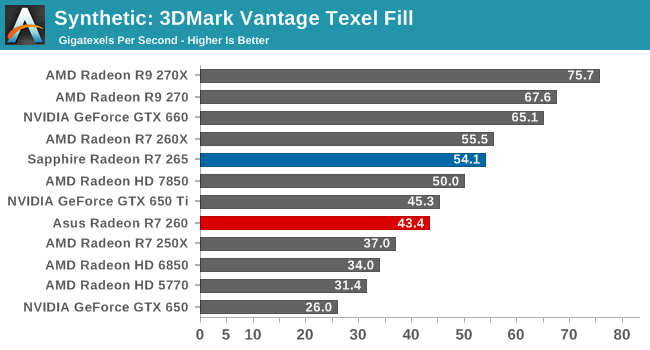
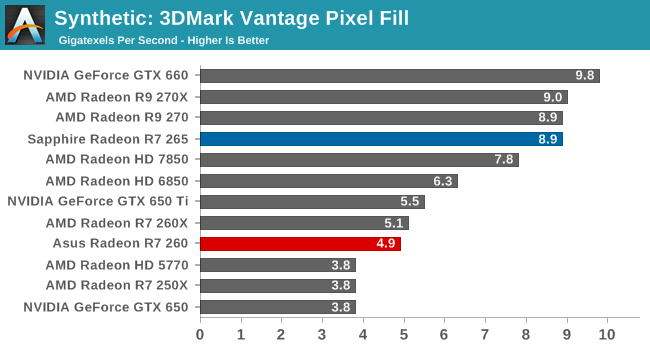
3DMark also finds an interesting edge case for us, once again relating to the number of processing units in R7 265. Texture throughput on R7 265 is slightly below R7 260X due to the fact that R7 260X’s 1.1GHz clockspeed more than makes up for the 12% deficit in the number of texture units available. The end result is that R7 260X is able to push more texels in a second than R7 265 can, even with fewer texture units to do it with.
Compute
Jumping into compute, we’re once again treading into familar territory. Pitcairn and Bonaire are Pitcairn and Bonaire, so this will result in the same general performance differences we've seen elsewhere.
As always we'll start with our DirectCompute game example, Civilization V, which uses DirectCompute to decompress textures on the fly. Civ V includes a sub-benchmark that exclusively tests the speed of their texture decompression algorithm by repeatedly decompressing the textures required for one of the game’s leader scenes. While DirectCompute is used in many games, this is one of the only games with a benchmark that can isolate the use of DirectCompute and its resulting performance.
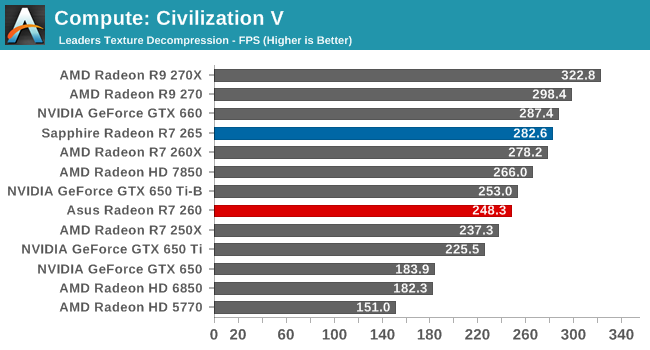
Similar to the 3DMark pixel throughput test on the last page, the Civilization V texture decompression tests highlights the fact that the R7 265 and R7 260X are closer than one would expect in certain edge cases. Once again the R7 260X’s higher clockspeed is helping it keep the gap between it and the R7 265 very narrow, as the two have very similar shader throughput in the end.
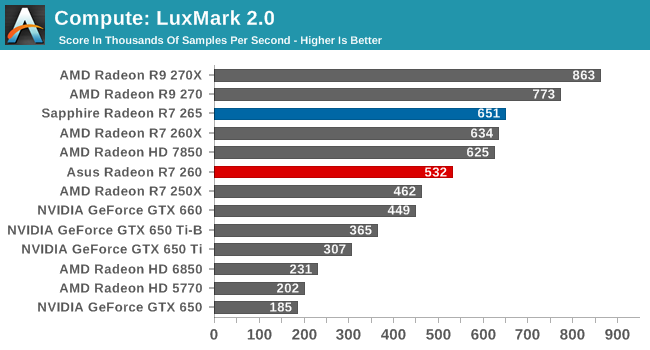
The story is much the same with LuxMark as it was Civilization V, with AMD cards once again being sorted almost exactly by shader throughput. Though it’s worth pointing out that NVIDIA’s performance under LuxMark has greatly improved as of the R334 drivers. It’s not enough to close the gap with AMD, but it’s closer than it once was.
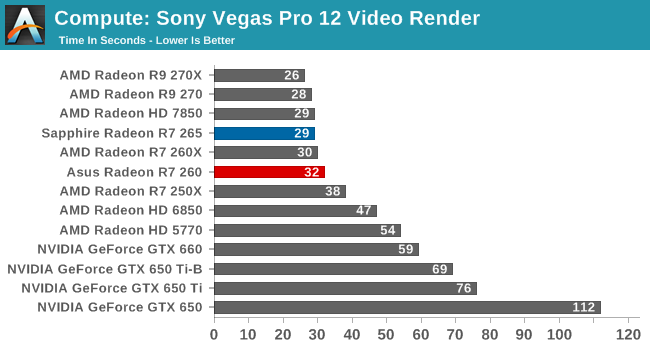
Like LuxMark, Sony Vegas is a benchmark dominated by AMD. The lead here is so great that the R7 265 could run this benchmark twice over before the GTX 660 completed it once. Nor would the R7 260 be too far behind in that respect.
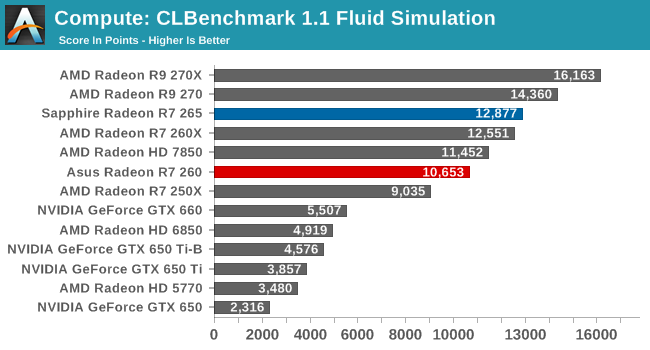
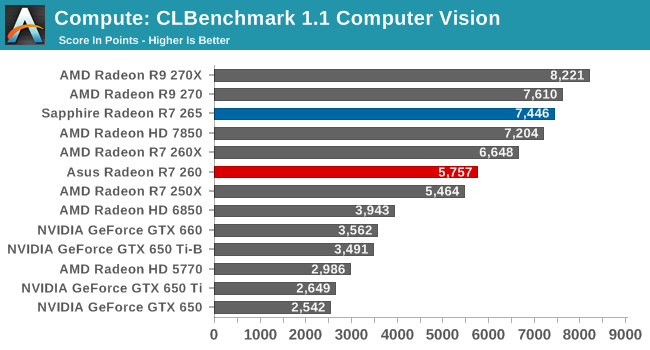
Both CLBenchmark’s fluid simulation benchmark and the computer vision benchmark go to AMD here. The GTX 650 Ti and GTX 660 are not competitive here.
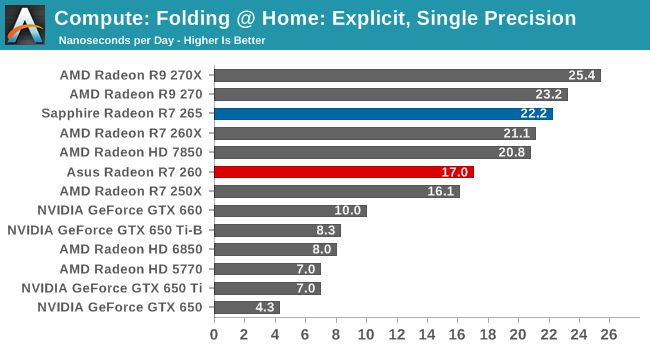
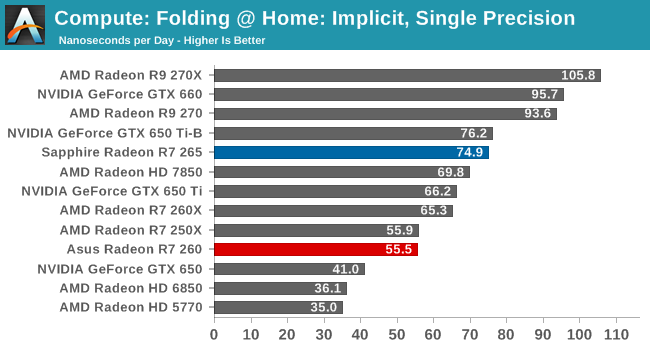
With AMD’s Catalyst 14.1 drivers, AMD has been able to increase their Folding @ Home performance by several percent, closing some gaps while widening others. In the Explicit SP benchmark AMD further increases their lead here, with even the lowly R7 250X holding a significant lead over the GTX 660. On the other hand the R7 265 can’t come close to the GTX 660 under Implicit SP; there’s a lack of raw shader throughput to make it happen.
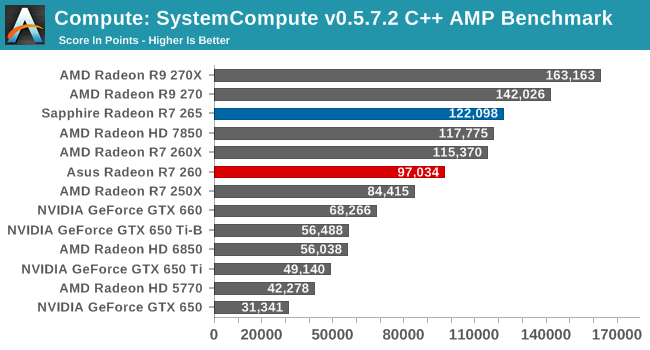
SystemCompute is another compute benchmark that goes to AMD. The R7 265 and R7 260 handily beat the GTX 660, never mind the GTX 650 Ti.
Power, Temperature, & Noise
As always, last but not least is our look at power, temperature, and noise. Next to price and performance of course, these are some of the most important aspects of a GPU, due in large part to the impact of noise. All things considered, a loud card is undesirable unless there’s a sufficiently good reason – or sufficiently good performance – to ignore the noise.
| Radeon R9 270 Series Voltages | ||||
| AMD R7 270 Boost Voltage | Sapphire R7 265 Boost Voltage | Asus R7 260 Boost Voltage | ||
| 1.188v | 1.175v | 1.225v | ||
Neither the R7 260 nor the R7 265 are remarkable as far as voltages are concerned. Both of these are right in the range of common voltages for lower clocked Pitcairn and Bonaire products respectively. Though this does reinforce the fact that R7 265 won’t see any significant power savings compared to R9 270.
| Radeon R9 270 Series Average Clockspeeds (Reported) | ||||
| Sapphire R7 265 | Asus R7 260 | |||
| Boost Clock | 925MHz | 1000MHz | ||
| Metro: LL |
925MHz
|
1000MHz
|
||
| CoH2 |
925MHz
|
1000MHz
|
||
| Bioshock |
925MHz
|
1000MHz
|
||
| Battlefield 4 |
925MHz
|
1000MHz
|
||
| Crysis 3 |
925MHz
|
1000MHz
|
||
| Crysis: Warhead |
925MHz
|
1000MHz
|
||
| TW: Rome 2 |
925MHz
|
1000MHz
|
||
| Hitman |
925MHz
|
1000MHz
|
||
| GRID 2 |
925MHz
|
1000MHz
|
||
Looking briefly at average clockspeeds, despite the fact that these cards implement different power control mechanisms – PowerTune Boost 1.0 and PowerTune Boost 2.0 respectively – the end results are the same. Neither card has difficulty maintaining its top clockspeed for their entire runs, this owing in large part due to the fact that they’re not under any significant thermal load that would require pulling back.

Starting as always with idle power consumption, we can see that all of our low-end cards are tightly clustered. With idle power consumption as good as it is for both AMD and NVIDIA, further improvements are relatively marginal by desktop standards and are essentially drowned out by the large PSU in our GPU testbed.
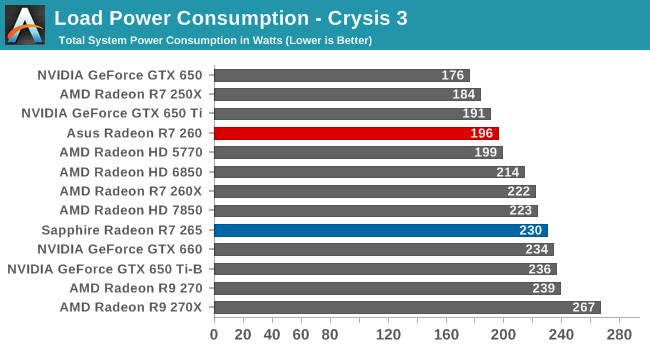
Power consumption under Crysis 3 closely mirrors relative performance, at least for our current-generation 28nm cards. The R7 260 for its part draws 196W at the wall, 15W-23W more than the R7 250X and GTX 650 cards it clearly outclasses, and 5W more than the GTX 650 Ti that it still manages to consistently beat. More interesting is that it’s drawing 26W at the wall less than the R7 260X, showcasing that AMD’s power numbers for these cards were in fact almost spot on, especially after accounting for the change in CPU power consumption.
Otherwise for the R7 265, we can see that power consumption slots in above the 7850 and R7 260X, and below the R9 270 by 9W, the kind of very limited change we were expecting. At the same time we can see just how close the R7 265 and GTX 660 are – separated by just 4W – which goes hand-in-hand with their similar performance.
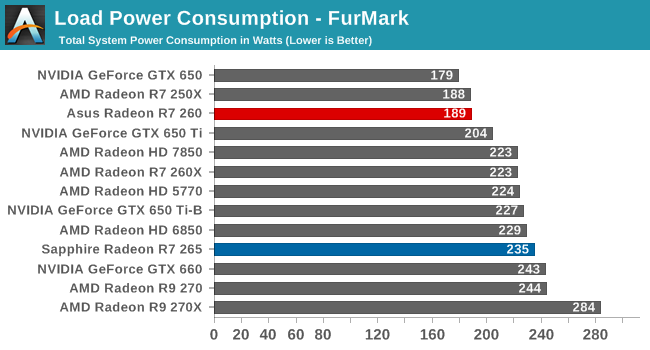
Under FurMark we do see some shifts in relative power consumption, though not relative rankings. At 189W the R7 260 is virtually tied with the less powerful 250X, underscoring Bonaire’s greater efficiency and improved power throttling mechanisms, while the 235W R7 265 once again slots in between the R7 260X and R9 270 by several watts in each direction.
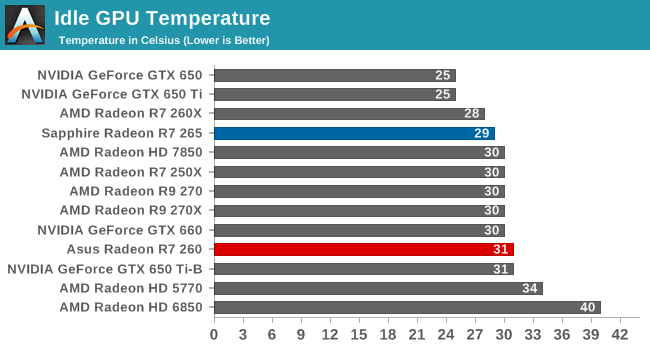
Moving on to temperatures, our idle temperatures are unremarkable. At 29C for the R7 265 and 31C for the R7 260 both cards do well enough, but they can’t touch the near room temperature operating temperatures of some of the NVIDIA 650 cards.

With both of today’s cards being low power open air cooled dual fan cards, there’s little concern for temperatures. Both cards are easily below 70C, with the more powerful R7 265 easily dropping to 55C due to its larger cooler. The R7 260 hits 66C despite its relatively low power, though Asus has clearly been targeting a balance between noise and temperatures as opposed to just maximum cooling in their more recent designs.
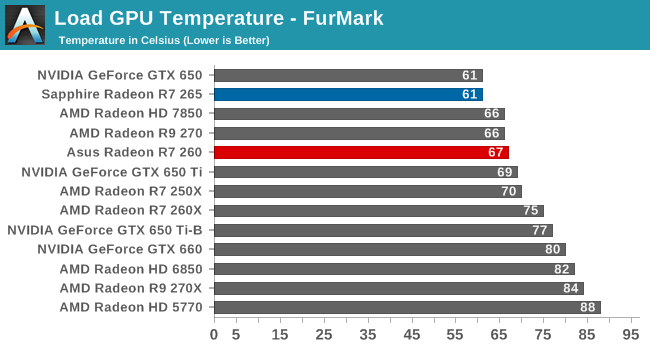
Of our two cards, the R7 265 gets the worse of FurMark relatively speaking, thanks in part to its coarser power throttling mechanisms. Regardless even when presented with a maximum load, both cards do well for themselves here, having no trouble staying below 70C.
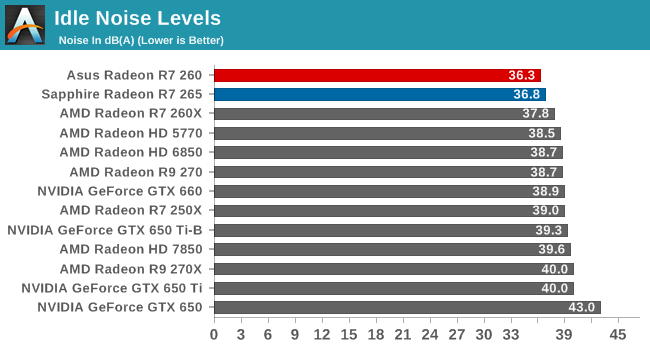
Last but not least we have our noise testing. Both the R7 260 and R7 265 do very well for themselves at idle, taking the #1 and #2 spots respectively. Both of these cards are functionally near-silent at idle, and this proves that both Asus and Sapphire did their homework by being able to hit these noise levels with a dual fan configuration, something not every vendor has had a ton of luck with over the years.

Once again both of today’s cards do very well here. Though the R7 260 is admittedly among the lowest powered cards here, and hence has the easiest time, it nevertheless takes the top spot at 38dB. This being quieter than both the GTX 650 and GTX 650 Ti, the two cards it’s closest to in power consumption and heat generation.
Meanwhile at 40.4dB is the R7 265, where Sapphire has managed to stay cool and quiet despite the nearly 150W the card can pull. At this point it’s still marginally quieter than the slower 260X and over 6dB quieter than the performance-competitive GTX 660 (though it should be noted that the GTX 660 is a blower).
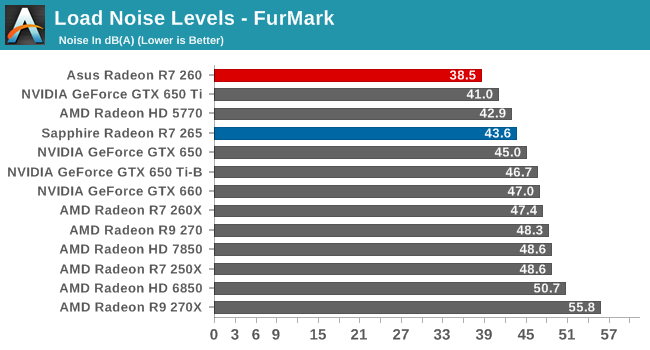
FurMark once again changes the picture, but only slightly slow. Even under this extreme workload Asus’s R7 260 comes away smiling, topping out at 38.5dB, 2.5dB less than the GTX 650 Ti. Otherwise we have the Sapphire R7 265 at 43.6dB, which gives up some of its edge from earlier but not much, easily besting the GTX 660 and R7 260X, but falling a bit short of the GTX 650 Ti.
Taken in altogether, both Asus and Sapphire have done good jobs with their R7 260 and R7 265 respectively. As we’ve seen both are able to hit low noise levels even for their relative classes, all the while easily maintaining low operating temperatures.
Otherwise from a power perspective as neither card is based on a new GPU, there are admittedly no real surprises to be had. Power roughly scales with performance, with the R7 265 as a 3rd tier part seeing a lesser benefit, and thereby falling a bit behind the efficiency curve as set by the higher tier Pitcairn parts.
Final Words
Bringing this review to a close, we have an admittedly straightforward scenario to look at. As AMD has already shown their cards by launching all of their GPUs for this generation, these lower tier mainstream parts don’t pack any great surprises. But they do fill important roles in AMD’s product lineup and represent a general increase in the price-to-performance ratio for video cards within the $100-$150 mainstream market. Which is all the more important in light of AMD’s restructuring of the R7 260 series and its associated price cuts.
Short and to the point then, this is one of my favorite kind of articles to write. By reducing Radeon R7 260X prices along with introducing the Radeon R7 265 and Radeon R7 260, AMD will be increasing their performance in this entire segment to the benefit of all, full stop. The R7 260, R7 260X, and R7 265 form a very impressive trio of cards that at their new prices should help satisfy customers who have been looking to upgrade from pre-GCN cards but have been dissatisfied with the performance of AMD’s sub-$150 lineup thus far.
To that end, once it begins shipping at the end of this month the R7 265 will bring with it an extremely significant increase in performance compared to the existing R7 260X, and only for a small change in price. Altogether we’re looking at an average performance increase versus R7 260X of 24% for a $10 (7%) increase in price, a very clear improvement in AMD’s price-to-performance ratio for their best sub-$150 card. More remarkable yet, on a competitive basis the R7 265 will easily beat the best of NVIDIA’s current lineup, if only because it’s between NVIDIA cards, outperforming the GTX 650 Ti by 48% and even breaking even with the more expensive GTX 660. Consequently on a price/performance basis this is going to put AMD in a very good position and will make the R7 265 the card to get at $150.
But with that said, AMD will be making the usual tradeoffs that come with reducing the prices of increasingly powerful cards, along with some new tradeoffs. Power consumption is going up slightly and power efficiency is going down slightly compared to the R7 260X and R9 270, as this is what usually happens in these situations. Meanwhile $150 AMD buyers will now be missing out on the feature benefits of GCN 1.1 such as TrueAudio, as R7 265’s Pitcairn GPU will not have that functionality present.
As for the R7 260, with the official launch already behind us this is less a discussion about what will be than what is. From a performance perspective the R7 260 nicely fills its intended (if narrow) role, slotting between the R7 250X and R7 260X. In fact R7 260 is a very significant step up given the circumstances, outperforming R7 250X by an average of 22% and even besting the GTX 650 Ti by 9%.
From a performance standpoint R7 260 is going to be extremely solid. The concern right now is that this is only the case if it is at its $109 MSRP. As strong as the card is right now, it’s too close to R7 260X in price for its 10% lower performance, and it’s in an especially bad spot if prices don’t finally come down once the R7 260X price cuts take effect. AMD and their partners are playing in an extremely price sensitive market with R7 260, so its success will depend on making sure it stays away from R7 260X.
Which brings us to our next point, which is pricing and availability. So long as AMD can ensure a solid supply and that retailers actually sell the R7 260 series cards at their MSRPs, then AMD is golden. However as we discussed in our introduction, the sketchy supply for the R9 270 series and the highly inflated prices leaves us worried as to whether AMD can deliver on their pricing promises at the moment. The biggest component of AMD’s restructuring of the R7 260 series is R7 265, and that’s the part that’s at greatest risk of being distorted since it uses the same Pitcairn GPU as the R9 270 series. Since the R7 265 won’t arrive for another two weeks anyhow we have plenty of time to wait and see how this progresses, and the hardware is solid regardless, but AMD does need to hit $149 with availability for all of this to work.
Speaking of two weeks, by allowing such a large gap between today’s product announcements and when those products will hit retail, AMD is showing their hand to consumers and NVIDIA alike relatively early. As hyper-competitive as the sub-$150 market is – keep in mind that in terms of volume, the majority of AMD’s sales are sub-$150 – major price cuts and new product launches do not go unnoticed or left without a response. So it will be interesting to see what, if anything, NVIDIA does to counter AMD’s restructuring of the R7 260 series.
Finally, let’s quickly recap our two board partner cards, Sapphire’s R7 265 and Asus’s R7 260. As far as performance is concerned both of these are stock cards, so there’s little to say regarding their performance that hasn’t been said above. As for their customizations and designs as it relates to build quality and cooling, both look to be very capable contenders. Most importantly, both cards had no problem hitting a proper balance between temperatures and acoustics, offering great temperatures with very low noise levels. We’ll see what other partners’ cards bring in due time once more cards launch, but it’s clear that neither card is going to be easy to beat.

